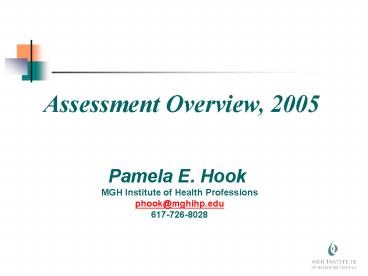Assessment Overview, 2005 - PowerPoint PPT Presentation
1 / 36
Title:
Assessment Overview, 2005
Description:
Sentence/Passage Comprehension (K-12) Sample Tests Group Comprehension (cont. ... Sentence/Passage Comprehension (K-12) Automaticity/Fluency. Automaticity ... – PowerPoint PPT presentation
Number of Views:37
Avg rating:3.0/5.0
Title: Assessment Overview, 2005
1
Assessment Overview, 2005
Pamela E. Hook MGH Institute of Health
Professions phook_at_mghihp.edu 617-726-8028
2
Types of Assessment
- Screening
- Diagnostic
- Progress Monitoring
- Outcomes
3
Screening Assessment
Purpose To identify children in need of extra
instructional supports
4
Diagnostic Assessment
Purpose To determine student's specific
instructional needs
5
Progress Monitoring Assessment
Purpose Ensure that adequate progress in
reading growth is being achieved throughout the
yearalso called Formative Assessment or Dynamic
Assessment
6
Outcomes Assessment
Purpose To evaluate overall reading
outcomesalso called Summative Assessment
7
Other Important Characteristics of Assessments
- Norm Referenced (often used for Screening,
Diagnostic and Outcomes Assessments) - Criterion Referenced (often used for Progress
Monitoring) - Timed or Untimed
- Individual or Group
8
Many tests can serve more than one purposethe
goal is to find the most effective and efficient
battery.
9
Key Characteristics of Struggling Middle School
and Secondary School Readers (cont.)
Difficulty in one or more of the areas related to
the processes involved in reading (word
identification and comprehension), motivation or
the characteristics of the text. (See p. 21 of
Building Reading Proficiency at the Secondary
Level A Guide to Resources, 2000)
10
Underlying Processes Involved in Reading /Areas
to Assess (National Reading Panel, 2000)
- Comprehension
- Vocabulary
- Fluency
- Word Study/Spelling
- Phonemic Awareness
11
Sample TestsGroup Comprehension
- GRADE (Group Reading Assessment Diagnostic
Evaluation)(untimed 45-60 min.)
Screening/Diagnostic/Outcomes - Listening Comprehension (K-12)
- Word Meaning and Word Meaning/ Vocabulary (K-12)
- Sentence/Passage Comprehension (K-12)
12
Sample TestsGroup Comprehension (cont.)
- DRP (Degrees of Reading Power)text
comprehensioncloze procedure (untimed but
estimated about one class period)Screening/Diagno
stic/ Progress Monitoring - Gates Mac-Ginitiesimilar to GRADE but no
listening comprehension (timed)
13
Vocabulary
High-knowledge third graders had vocabularies
about equal to lowest-performing twelfth graders
(Smith, 1941)
14
Sample TestsGroup Vocabulary
- GRADE (Group Reading Assessment Diagnostic
Evaluation)(untimed 45-60 min.)
Screening/Diagnostic/Outcomes - Listening Comprehension (K-12)
- Word Meaning and Word Meaning/ Vocabulary (K-12)
- Sentence/Passage Comprehension (K-12)
15
Automaticity/Fluency
Automaticity accuracy and rate Single Word
Level effortless identification of words
16
Automaticity/Fluency
Fluency automaticity (accuracy and rate) plus
rhythm/prosody/ syntactic chunking for
comprehension movement through text
anticipation Text Level coordination of
automatic word recognition with appropriate
phrasing and expression for comprehension
17
Sample TestsGroup Automaticity/Fluency
- TOSWRF (Test of Sight Word Reading Fluency)(Ages
5-24) (5 minutes)Norm referenced
Screening/Diagnostic
18
Sample TestsIndividual Automaticity/Fluency
- TOWRE (Test of Word Reading Efficiency)
automaticityoral reading of real and nonsense
words (5 minutes) Screening/Diagnostic - DIBELS (Dynamic Indicators of Basic Early
Literary Skills)fluencyoral paragraph reading
(10 minutes)Screening/ Diagnostic/ Progress
Monitoring (for all or at risk children)
19
Word Study/Spelling
- 74 of children who are poor readers in the
third grade remain poor readers in the ninth
grade (Lyon Alexander, 1996)
20
Phonemic Awarenesseffects on Reading and Spelling
Reading Errors aliki/alkali cristern/cistern ab
ommible/abdominal virile/vigil/virgil
Spelling Errors ecwimint/equipment lieture/literat
ure messety/necessity phision/physician
21
Orthographic ErrorsTest of Written Spelling
14 year old, 9th grader
secsion/section exspect/expect leagel/legal taribl
e/terrible ageracoltsher/agriculture vishwalis/vis
ualize
22
Sample TestsGroup Word Study/Spelling
Upper Elementary Spelling Inventory (Words their
Way, 2000)Criterion Referenced, Screening,
Diagnostic, Progress Monitoring
23
Sample TestsIndividual Word Study/
Phonological Awareness
- The Phonological Awareness Reading Profile
(Ages 8-14)Criterion referenced, Diagnostic - Phonological Awareness (Blending, Isolation
- Segmentation, Deletion, Manipulation)
- Decoding
- Spelling
- Fluency
24
Sample TestsIndividual Phonological Awareness
- CTOPP (Comprehensive Test of Phonological
Processing)(Ages 5-24)phonemic awareness, short
term memory, rapid naming (15 minutes)Norm
referenced Diagnostic (maybe selected subtests)
25
Individual children differ in their skills in
these areas
- Comprehension
- Vocabulary
- Fluency
- Word Study/Spelling
- Phonemic Awareness
26
How to Establish Flexible Groupings
Assessment drives instruction.
27
Core Components of a Comprehensive Literacy
Program
Comprehension Word Identification
28
Assessment Considerations
Is the information that is gathered
Across the Core Content Domains (Comprehension,
Vocabulary, Fluency, Word Study, Phonemic
Awareness)?
Will the information that is gathered
Inform instruction across the Core Content
Domains (Comprehension, Vocabulary,Fluency, Word
Study, Phonemic Awareness)?
29
Possible Flexible Groupings Based on Test Data
Low Risk (40-75ile) On Grade Level CORE
Some Risk (25-40ile) Below Grade
Level Supplemental
At Risk (lt25ile) Significantly Below
Grade Intensive
Advanced (gt75ile) Above Grade Level CORE plus
Support in Word Identification
both Comprehension
30
Possible Flexible Groupings Based on Test Data
- Average to good reading
- Word Identification/Spelling Issues
- Comprehension Issues
- Mixed Word Identification/Comprehension Issues
- ELL students with good reading in native
language - ELL students with reading difficulties
31
Possible Flexible Grouping Types
Which assessed areas would you expect to be
strengths (), which weaknesses (-) and which
either (?) for each type of flexible group?
32
Average to Good Readers
FOCUS Developmental reading skills Blooms
Taxonomy--Curriculum Frameworks (Higher Order
Thinking Skills, Study Skills, Research Paper)
33
Word Identification/Spelling Issues
(Underlying spoken language is
good) FOCUS Structured, systematic approach to
(phonemic awareness), word study,
fluency, comprehension, vocabulary, and
writing--heavy emphasis on word study
integrated with other areas
34
Comprehension Issues
(Word Identification is
good) FOCUS Structured, systematic approach to
fluency, comprehension, vocabulary, and
writing--heavy emphasis on oral
language development
35
Both Word Identification/Comprehension Issues
FOCUS Structured, systematic approach to
(phonemic awareness), word study, fluency,
comprehension, vocabulary, and writing--heavy
emphasis on word study and oral language
development integrated with other areas
36
ELL students with good reading in native language
Emphasis on development of English language skills
ELL students with reading difficulties in native
language
Emphasis on development of reading skills and
English language skills































